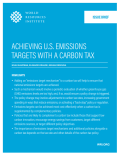
Achieving U.S. Emissions Targets with a Carbon Tax provides insight on how incorporating emissions target mechanism into a strong national carbon tax can help ensure intended emission cuts are achieved. This mechanism establishes predictable ways of adapting the carbon pricing program over time to respond to any shortfall in emissions reductions. The report describes a basic two-step process– periodic evaluation of whether emissions reductions are on track to meet targets followed by an adjustment mechanism if reductions are less than anticipated.
This report highlights following points:

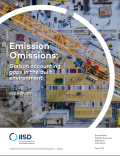
Life-cycle assessment (LCA) studies are the main tool used to measure the carbon footprints of building products at each phase of their cradle-to-grave lifespan (i.e. production, use, and end of life). While LCAs are the best-available tool for evaluating the greenhouse gas (GHG) performance of alternative building products and designs, policy makers and building designers should be aware there are also limitations, challenges, and uncertainties. Therefore, the purpose of this report is to identify:
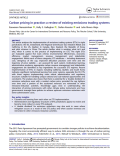
Carbon Pricing in Practice: A review of existing emissions trading systems analyses the implementation of emissions trading systems (ETSs) in eight jurisdictions: the EU, Switzerland, the Regional Greenhouse Gas Initiative (RGGI) and California in the US, Québec in Canada, New Zealand, the Republic of Korea and pilot schemes in China. The article clarifies what is working, what isn’t and why, when it comes to the practice of implementing an ETS.
The eight ETSs are evaluated against five main criteria: environmental effectiveness, economic efficiency, market management, revenue management and stakeholder engagement. Within each of these categories, ETS attributes − including abatement cost, stringency of the cap, improved allocation practices over time and the trajectory of price stability − are assessed for each system.
One method to reduce greenhouse gas emissions is to subsidize emissions-reducing activities. The question is how to allocate such subsidies. Allocation through auctions is an emerging mechanism. In a controlled experimental market setting, this paper compares the effects of a variety of auction mechanisms for allocating subsidies for carbon emissions reduction in China. Besides the conventional auction mechanisms, this discussion paper place particular focus on testing the actual performance of the auction mechanism proposed by Erik Maskin (2011). The authors find that, while the Maskin auction mechanism spends the most from a fixed subsidy budget and leads to the largest emissions reduction, its per-unit emissions reduction cost is higher than that of discriminatory and uniform-price auction mechanisms. Both the Maskin and uniform-price auctions outperform discriminatory auctions in price discovery. Furthermore, from the government’s perspective, the Maskin auctions exhibit the strongest improvement tendency with repeated auctions.

With the sun gradually setting on the Kyoto Protocol (Phase One), it has become quite apparent that the global response to resource scarcity and climate change is going to be variable and disaggregated.
Increasingly, countries and businesses across the globe are adopting various financial mechanisms and policies in order to manage such challenges. However, many such responses are restricted to advanced, developed countries, whereas the effects of climate change and the increasing cost of resources such as fossil fuels are likely to be more severe for developing countries. This dichotomy in response measures needs to be urgently addressed, and this report is an attempt to highlight the benefits of an inclusive growth oriented financial response mechanism with particular focus on India.
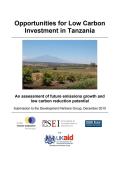
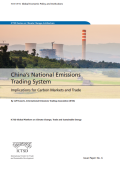
China’s introduction of a national ETS, scheduled for 2017, is an important development in the expanding carbon market landscape. As countries move towards implementation of the recently-adopted Paris Agreement, this sends a powerful signal about China’s mitigation commitment and support for carbon markets. As the largest emitter of greenhouse gases and a key player in world trade, China’s move to a nation-wide ETS can have significant implications for the future of carbon markets around the world.

